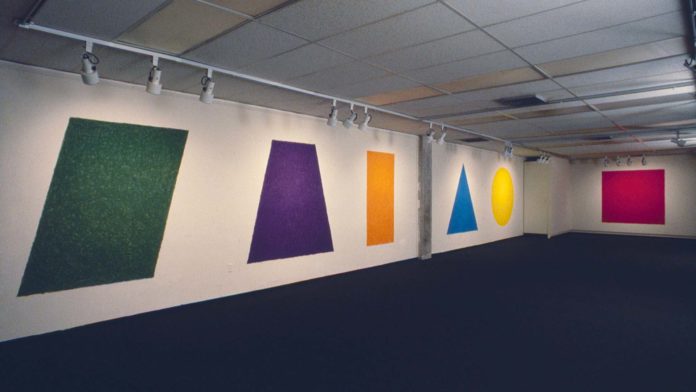Art Styles and Artists that Use Geometric Shapes
- Ellsworth Kelly
- Wassily Kandinsky.
- Frank Stella
- Pablo Picasso.
- Piet Mondrian.
- Bridget Riley.
- Georges Vantongerloo.
- Robert Morris.
- Mary Corse.
- William Roberts.
- Rafael Montilla.
The first thing to come to mind when thinking about geometry is math, but geometry is also very present in art. Discover the role geometric shapes play in art, including the various stylistic movements and the artists that use them. Updated: 10/11/2021
Definition of Geometric Shapes
Have you ever wondered how artists actually create art? Once they’ve chosen a subject matter, gathered their supplies, and picked up a paintbrush for the first time – what happens next? Sometimes starting with a simple square – or other geometric shape – is the answer.
Geometric shapes come from geometry, which is the math of shapes made of points and lines. Geometric shapes are shapes made out of points and lines including the triangle, square, and circle. Other shapes are so complex that it takes math in order to create them. These shapes are the opposite of organic shapes. While geometric shapes are more precise, organic shapes are natural. In this lesson, we will take a look at geometric shapes.
Geometric Shapes in Art
Let’s take a look at some movements and artists that use geometric shapes:
Bauhaus
Bauhaus was a German school of art that came out of the arts & crafts movement. The arts & crafts movement was more about flowing lines and flowery lines. Bauhaus was in direct opposition to that – it used geometry. Some German architecture that used the Bauhaus geometries still stands today in the cities Bauhaus was founded in.
Wassily Kandinsky, one of the fathers of abstract modern art, painted geometric shapes to represent spirituality and emotions. It was during the Bauhaus period that he found geometrics playing more of a role in his work.
Cubism
Cubism evolved around 1907-1914 in Spain and France. Pablo Picasso and Georges Brauque created surrealistic works using cube shapes. This means they took images that would be organic, meaning natural and flowing, and recreated them as if they were just planes and angles.
Geometric forms are forms that are mathematical, precise, and can be named, as in the basic geometric forms: sphere, cube, pyramid, cone, and cylinder. A circle becomes a sphere in three dimensions, a square becomes a cube, a triangle becomes a pyramid or cone.
Geometric forms are most often found in architecture and the built environment, although you can also find them in the spheres of planets and bubbles, and in the crystalline pattern of snowflakes, for example.
Organic forms are those that are free-flowing, curvy, sinewy, and are not symmetrical or easily measurable or named. They most often occur in nature, as in the shapes of flowers, branches, leaves, puddles, clouds, animals, the human figure, etc., but can also be found in the bold and fanciful buildings of the Spanish architect Antoni Gaudi (1852 to 1926) as well as in many sculptures.
What is geometric artwork?
Geometric art is an artistic movement created in the early 20th century by artists with a fascination for geometric shapes. Geometric Art is created using geometric elements, shapes… Geometric art is inspired by geometry. Geometry is a branch of mathematics related to the shape, size, and relative position of figures.
Why do artists use geometric shapes?
In art, geometric shapes such as circles, lines, squares, and triangles are all used to define and organize space. The use of geometric shapes in art allows artists to express and isolate emotions; Wassily Kandinsky is well-known for expressing spirituality in his later work.
Who started geometric art?
Kazimir Malevich
One of the pioneers and most emblematic artists of abstract geometric art was Kazimir Malevich, who founded the Suprematist movement. His purpose was the search of an absolute and pure expression, nonfigurative, unlike customary art.
When was geometric abstract art popular?
1910 – 1960
Although the genre was popularized by avant-garde artists in the early twentieth century, similar motifs have been used in art since ancient times.
Madí Art movement
Madí is an international abstract art movement initiated in Buenos Aires in 1946 by the Hungarian-Argentinian artist and poet Gyula Kosice, and the Uruguayans Carmelo Arden Quin and Rhod Rothfuss. The movement focuses on creating concrete art and encompasses all branches of art.
Source: https://www.thoughtco.com/definition-of-form-in-art-182437













